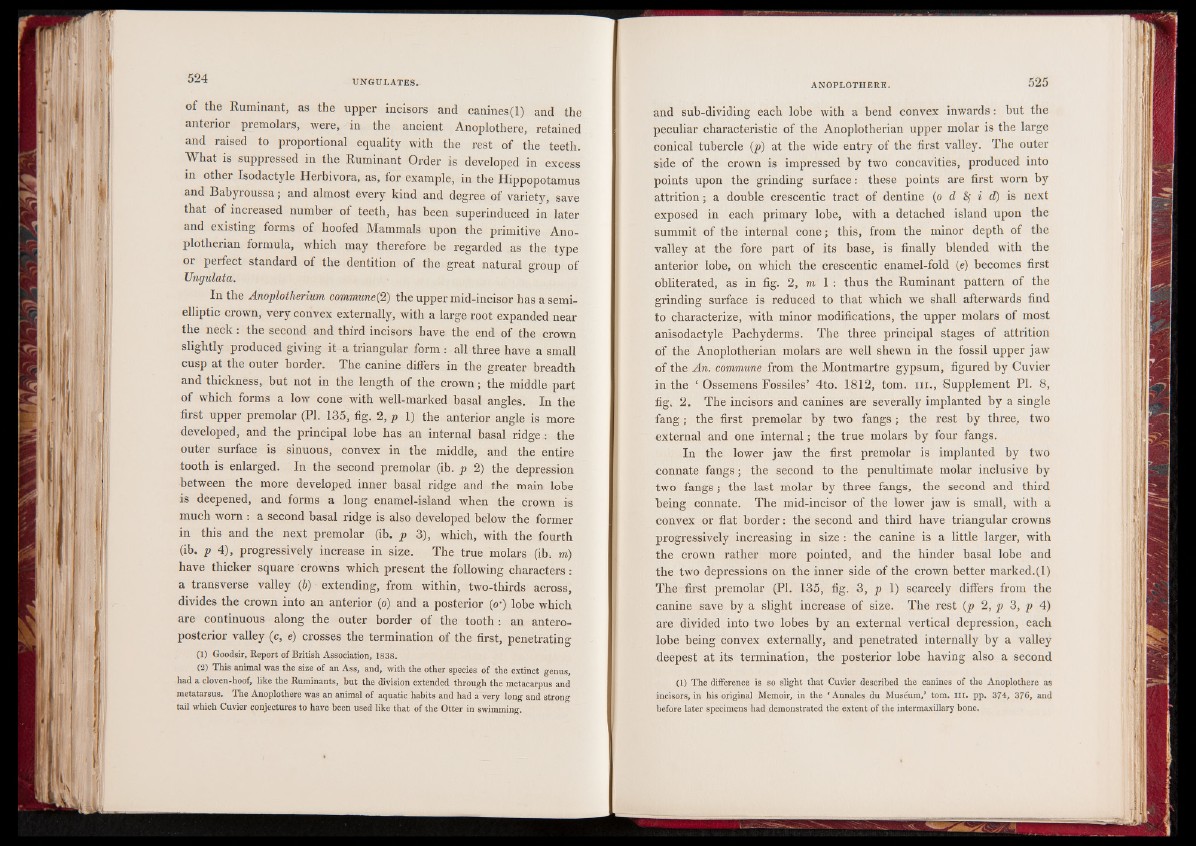
of the Ruminant, as the upper incisors and canines(l) and the
anterior premolars, were, in the ancient Anoplothere, retained
and raised to proportional equality with the rest of the teeth.
What is suppressed in the Ruminant Order is developed in excess
in other Isodactyle Herbivora, as, for example, in the Hippopotamus
and Babyroussa | and almost every kind and degree of variety, save
that of increased number of teeth, has been superinduced in later
and existing forms of hoofed Mammals upon the primitive Ano-
plotherian formula, which may therefore be regarded as the type
or perfect standard of the dentition of the great natural group of
Ungulata.
In the Anoplotherium commune(2) the upper mid-incisor has a semi-
elliptic crown, very convex externally, with a large root expanded near
the neck i the second and third incisors have the end of the crown
slightly produced giving it a triangular form : all three have a small
cusp at the outer border. The canine differs in the greater breadth
and thickness, but not in the length of the crown; the middle part
of which forms a low cone with well-marked basal angles. In the
first upper premolar (PI. 135, fig. 2, p 1) the anterior angle is more
developed, and the principal lobe has an internal basal ridge : the
outer surface is sinuous, convex in the middle, and the entire
tooth is enlarged. In the second premolar (ib. p 2) the depression
between the more developed inner basal ridge and the main lobe
is deepened, and forms a long enamel-island when the crown is
much worn : a second basal ridge is also developed below the former
in this and the next premolar (ib. p 3), which, with the fourth
(ib. p 4), progressively increase in size. The true molars (ib. m)
have thicker square crowns which present the following characters:
a transverse valley (6) extending, from within, two-thirds across,
divides the crown into an anterior (o) and a posterior (o') lobe which
are continuous along the outer border of the tooth: an anteroposterior
valley (c, e) crosses the termination of the first, penetrating
(1) Goodsir, Report of British Association, 1838.
(2) This animal was the size of an Ass, and, with the other species of the extinct genus,
had a cloven-hoof, like the Ruminants, but the division extended through the metacarpus and
metatarsus. The Anoplothere was an animal of aquatic habits and had a very long and strong
tail which Cuvier conjectures to have been used like that of the Otter in swimming.
and sub-dividing each lobe with a bend convex inwards : but the
peculiar characteristic of the Anoplotherian upper molar is the large
conical tubercle (p) at the wide entry of the first valley. The outer
side of the crown is impressed by two concavities, produced into
points upon the grinding surface : these points are first worn by
attrition ; a double crescentic tract of dentine (o d fy i d) is next
exposed in each primary lobe, with a detached island upon the
summit of the internal cone ; this, from the minor depth of the
valley at the fore part of its base, is finally blended with the
anterior lobe, on which the crescentic enamel-fold (e) becomes first
obliterated, as in fig. 2, m 1 : thus the Ruminant pattern of the
grinding surface is reduced to that which we shall afterwards find
to characterize, with minor modifications, the upper molars of most
anisodactyle Pachyderms. The three principal stages of attrition
of the Anoplotherian molars are well shewn in the fossil upper jaw
of the An. commune from the Montmartre gypsum, figured by Cuvier
in the ‘ Ossemens Fossiles’ 4to. 1812, tom. h i ., Supplement PI. 8,
fig. 2. The incisors and canines are severally implanted by a single
fang ; the first premolar by two fangs ; the rest by three, two
external and one internal ; the true molars by four fangs.
In the lower jaw the first premolar is implanted by two
connate fangs ; the second to the penultimate molar inclusive by
two fangs ; the last molar by three fangs, the second and third
being connate. The mid-incisor of the lower jaw is small, with a
convex or flat border : the second and third have triangular crowns
progressively increasing in size : the canine is a little larger, with
the crown rather more pointed, and the hinder basal lobe and
the two depressions on the inner side of the crown better marked. (1)
The first premolar (PI. 135, fig. 3, p 1) scarcely differs from the
canine save by a slight increase of size. The rest (p 2, p 3, p 4)
are divided into two lobes by an external vertical depression, each
lobe being convex externally, and penetrated internally by a valley
deepest at its termination, the posterior lobe having also a second
(1) The difference is so slight that Cuvier described the canines of the Anoplothere as
incisors, in his original Memoir, in the ‘Annales du Muséum,’ tom. in . pp. 374, 376, and
before later specimens had demonstrated the extent of the intermaxillary bone.